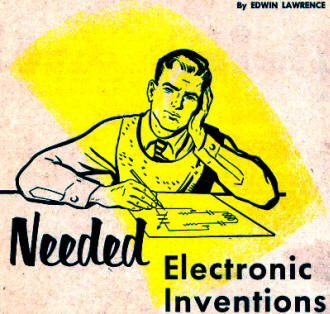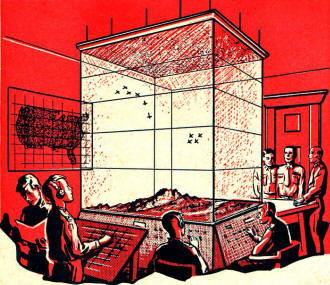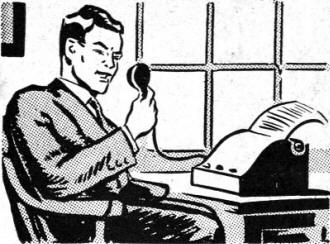Needed: Electronic Inventions
|
|
I and others joke frequently about the promise of flying cars, automated homes, and miracle pills to cure any maladies that were predicted to be commonly available by the end of the 20th century. Magazines like Popular Science, Mechanix Illustrated, Science and Mechanics, et al, regularly printed stories about these and a host of other inventions that were just around the corner. Most have never been realized, but we're appreciative of the dreamers and those people who dedicated their lives - often to the point of financial and/or physical ruin - while trying to succeed. Taking a different approach, Edwin Lawrence, in this 1956 article in Popular Electronics, solicits readers to consider inventing a few "needed inventions" that he throws out. Among them death ray that will incapacitate or kill at great distances, a speech-into-writing translator, a buried explosive detector, a 3-dimensional visual display, a device for recording television programs, and a handful of other ideas. Interested parties are bade to contact the National Inventor's Council, which was actually a department of the CIA (who knew PE was a puppet of a spy organization?). If you look through the article, particularly the aforementioned items listed, you will realize that most (if not all) are actually available today in some form! Needed: Electronic Inventions If you have a practical solution to any of the problems presented here, contact the National Inventor's Council. By Edwin Lawrence A death ray that will kill at 500 yards! An electronic typewriter which converts speech directly into typed reports! Are these devices from the 25th century or machines from a flying saucer? No. They are only two of the instruments considered worthy of serious work by independent American inventors. In recent years there has been a tendency for many to think that only large corporations and giant research laboratories could make material contributions to technical development. This is not and has never been true. The American people represent a vast reservoir of inventive talent, creative ability, and technical skill. Individuals, working in basement laboratories and small shops, can still and will continue to make major contributions to science, engineering, and industry. This is as true in the field of electronics as it is in any field, whether engineering, medicine, physics, or chemistry. In 1940 formal recognition of the part that America's individual inventors and scientists could play in national defense was given when the Secretary of Commerce, with the approval of the President, created the National Inventor's Council. One of the Council's primary functions is to consider suggestions and inventions offered by individuals. It is staffed by a number of eminent engineers, scientists, industrialists, and military men, all of whom lend their specialized services without compensation. The National Inventor's Council serves in an advisory capacity to the Armed Services and to other government agencies. It acts to consolidate and to make known some of the problems encountered by the military services. In this way the inventive genius of the public will be directed along lines which will result in needed inventions or in the solution of pressing technical problems. During the years since its organization, the Council has considered literally hundreds of thousands of proposals. A number of these have been acceptable and have resulted in incalculable savings in lives, material, time, and money. In order to aid in its work, the Council has issued periodically lists of "needed inventions" or "technical problems" to inventors, scientists, engineers, and technicians throughout the nation. These lists have covered practically every field, including medicine, food processing, construction techniques, communications, electronics and transportation. A number of the more interesting "electronic" problems from recent lists are stated below with additional comments and, in some cases, possible solutions. Read the list carefully. As a Popular Electronics reader, you are one of a great group of Americans who are interested in science and progress. You undoubtedly have many original ideas. Perhaps you can suggest practical solutions to some of these problems and, by doing so, help both yourself and your nation. If you have practical suggestions, or if you would like a complete list of problems, write to The National Inventors Council, Department of Commerce, Washington 25, D. C. Buried Explosive Detector A number of mine detectors have been developed and used in the past. Although many of these have performed satisfactorily under ideal conditions, others have failed to operate under specialized circumstances. When a mine detector fails to locate even one buried explosive in a field, that one error may result in the loss of several lives or in the destruction of a valuable piece of equipment. In the past, a number of techniques have been used, including both high- and low-frequency radio waves. It may be that an entirely new approach is needed, possibly one using ultrasonic vibrations. Regardless of the technique used, it should be one which will set off the explosive only at a safe distance from the operator. Radio-Proof Electric Blasting Cap Electric blasting caps must be used under some conditions. Unfortunately, many of the present-day blasting caps may be accidentally set off by high-energy radio signals. An inexpensive and efficient electric blasting cap which will not be set off by powerful radio or radar signals is needed. Microwave Oscillator If you're a ham operator, here's a good problem. There is a need for a microwave oscillator, suitable for both continuous-wave and pulsed operation, with an output of 1 kw. or more. A useful oscillator would be one that will deliver high power signals at 1000 mc. and higher frequencies. One that could deliver high power at 3000 mc. and over would be especially valuable. Most present-day oscillators are incapable of delivering extremely high powers at microwave frequencies for any period of time. However, technical advances are continually being made in this field. Therefore, if you have a potential solution, be sure to check technical literature for the status of other developments in order to avoid any duplication. Recorder for High-Frequency Range Some type of recorder is needed for recording signals beyond the range of from 5 to 1000 mc. per second, with either immediate playback or long-time storage before playback. Wire recorders have not yet been developed with this wide-frequency range. Tape recorders have been developed with frequency ranges adequate for television work, but even these do not encompass the range from 5 to 1000 mc. Perhaps some type of "dielectric" recorder will do the job. Portable Power Source There is a continuing need for an efficient, compact electric power source for both field and portable (mobile) work. At the present time, storage and "throw-away" dry batteries are used extensively; but both of these have disadvantages. Storage batteries require frequent recharging and throw-away batteries require frequent replacement. This constitutes a serious problem in front line locations. In addition, where a moderate to large amount of power is required, the weight of a battery power source becomes excessive. Gasoline-driven generators are too noisy for many applications. The recently announced solar and atomic batteries are still in the experimental stage and are far from being suited to field applications at this time. They are also fairly expensive and will probably continue to be so for some time in the future. One possible solution might be a small sealed gas turbine with an efficient muffler and driving a small generator. Still other solutions might be found in heat- or light-powered electrical energy sources. The problems of converting light and heat energy into electrical energy have been of long standing. Many experiments have been conducted with self-generating photocells, solar batteries, and similar devices. However, most of the experimental units for converting light into electrical energy have been expensive and have been incapable of delivering really large amounts of power. Thermocouples and pressure-type gas burners have been tried as possible solutions for converting heat into electrical energy but, again, a completely satisfactory solution has not been found. Regardless of the method used; essential requirements are that the device be reasonably efficient, foolproof, fairly light in weight, of reasonably small size, and extremely sturdy in order to withstand the rigors of field use under combat conditions. A device which generates electrical energy from heat should be capable of using several types of fuel, such as gasoline, diesel oil, kerosene, and alcohol. Any device suggested should operate efficiently under varying atmospheric and humidity conditions and over the temperature range from -65° to +165° F. Three-Dimensional Information Display Three-dimensional radar displays would expedite handling of aircraft near airports as well as improve coastal defenses. Possibly miniature aircraft could be individually activated in a "tank" duplicating area under surveillance. There is a need in the radar display field for a means of presenting three-dimensional information. Radar display units are used to provide a "shadow map" of the covered area, but these are flat and give only two-dimensional information. A "stereo" system in which two cathode-ray tubes are employed is not adequate because it does not permit any degree of accuracy in determining measurements in the three dimensions. A truly three-dimensional display would not only have wide application in military work, but might have wide commercial application in the development of a three-dimensional television system for home use. Trajectory Indicator One badly needed device is an indicator to show accurately the path of a missile with respect to target aircraft. Several means may be used for indicating a trajectory ... photographic, radio, television, radar, or acoustic. However, for military use the system employed should be accurate, fairly easy to use, and capable of indicating the closest approach of the missile to the aircraft, as well as the trajectory. An indicator is needed so that the paths of missiles can be closely checked and improvements can be made in guided missile design to insure greater accuracy. In many cases, it is difficult to tell exactly how close an approach has been made to a target aircraft unless a direct hit is made which destroys both the experimental missile and the expensive target aircraft. Underwater Target Detection Some means, other than sonic, is needed for determining the direction and range of an underwater target, such as a submarine. Most of the systems used today depend on the transmission of sound vibrations through the water for their operation. Attempts have been made to use radio and radar-like devices under water but, in general, these have not been too successful. Even though present sonic systems are satisfactory for many applications, they do have some limitations. A supplemental system is also desirable for checking purposes: Communication System A completely new form of communication is needed by the military. It could be an ultra-sonic "carrier" wave. In this drawing, the soldier is using a combination "microphone/earphone" that is plugged into his ear. A revolutionary new method of transmitting intelligence and information is needed to supplement and to replace conventional systems. Present systems, in general, depend on electrical impulses or signals sent over wires (telephone and telegraph), radiated waves (radio and television) and sound waves, or light waves (blinker). The Armed Forces would like a system utilizing completely new concepts. To develop such a system, it will probably be necessary for the inventor to work out a completely new approach utilizing new principles. It may be that a system utilizing an ultrasonic "carrier" wave will offer some possibilities. Destructive Ray The Armed Forces have been looking for a destructive ray for some time. Although "disintegration rays" and "death rays" have been described frequently in science-fiction, an entirely satisfactory method of producing such rays has not yet been developed. Death rays would be of considerable value in augmenting present weapons, such as mortars, guns, rockets, and flame throwers. However, to be completely useful, the ray should be capable of inflicting damage equal to or in excess of that produced by conventional weapons of similar size and range. It should be portable for field use, usable at distances of at least 500 yards, not require excessive power, and, of course, it should be practical. For example, there would be little point in using a death ray which required careful aiming in order to kill an enemy soldier in the open at 500 yards. A rifle bullet would do the same job and would be a lot cheaper. Several types of "death rays" have been developed, but experiments thus far indicate that the equipment would be bulky, difficult to control, of a limited range, and would require fantastic amounts of electrical power. Speech-into-Writing Translator A typewriter that evaluates the spoken word and processes speech to printed mailer would be welcomed. This "invention" may require a new approach before it can be evolved. Not only the military, but industry and business as well, could use a lightweight unit capable of translating ordinary speech into the written word. It would be valuable for speeding up communications and for intercepting radio and wire transmissions. All the approaches tried thus far have indicated that the apparatus required would be complicated, bulky, and expensive, and would do a far from satisfactory job. An "ideal" unit should not be appreciably larger than a present-day tape recorder. A person could speak into a microphone and the speech would be translated into a written or typed message, either on a flat sheet, or on a continuous strip of tape. It may be that a new approach utilizing transistorized, subminiature circuitry will result in a satisfactory solution. However, because of the differences in voices, the various accents people use, and the differences in the spelling and meaning of words that are pronounced similarly, the problems of developing such a device are many. Most of the "needed inventions" described above have been either new systems or relatively complex pieces of equipment. But the lists issued by the National Inventor's Council also contain a number of relatively simple components and new chemicals and materials.
Posted July 1, 2021 |
|





